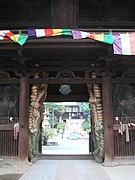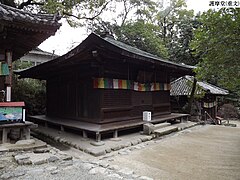Ishite-ji
The Ishite-ji ( Japanese 石 手 寺 ) with the mountain name Kumanosan ( 熊 野山 ) and the sub-temple name Kokūzō-in ( 虚空 蔵 院 ) is a temple of the Buzan branch ( 豊 山 派 Buzan-ha ) of the Shingon direction of Buddhism in the Matsuyama city , Japan. It is the 51st temple on the Shikoku pilgrimage route .
history
According to tradition, the temple is said to have been built in 728 at the request of the emperor Shōmu . Originally the temple is said to have been called Anyō-ji ( 安 養 寺 ) and from 813 it had the current name Ishite-ji.
The attachment
You enter the temple through a covered passage. At the end of it is that
- Niō-mon temple gate ( 仁王 門 ; 1 on the map), which is registered as a national treasure. It dates from 1318, has a saddle hip roof that is covered with tiles and shows an old Japanese style. Between the horizontal bars in the middle passage, a "toad belly " ( 蟇 股Kaerumata ) serves as an intermediate support. The two temple guards ( 金剛 力士 Kongō rikishi ) are registered as a cultural asset of the prefecture.
- The main hall ( 本 堂 , Hondō ; important cultural asset of Japan , marked below with;; 2) in advance dates from the middle Kamakura period . It is made in the so-called Japanese style , has a simplified saddle hip roof that is covered with tiles.
- The Daishidō ( 大師 堂 ; 3), the hall dedicated to the temple founder, stands to the right of the main hall and is connected to it by a corridor.
- The "three-story pagoda" ( 三重 塔 Sanjū-no-tō ; 4) is to the right of the main hall. It is 24.1 m high and is tiled. The basic structure also follows the Japanese style, but some of the supporting beams show features of the Daibutsu style .
- The bell tower ( 鐘楼 Shōrō ; 5) dates back to 1333. It has a sweeping saddle-hip roof that is covered with shingles. The temple bell ( 梵 鐘 Bonshō ; ◎) was cast in 1251.
- The "Goma Hall" ( 護 摩 堂 -dō ; ◎; 6) has a square floor plan and is covered with sheet copper. It comes from the Muromachi period .
- The " Kariteimo place of prayer" ( 訶 梨 帝 母 天堂 Kariteimo-tendō ; ◎; 7), in which the Holy Kariteimo, a kind of Mary with child, is venerated, is located on the northeast corner of the temple grounds. Popularly she is called "Holy Kishimojin" ( 鬼子母 神 ) , who helps pregnant women to have a happy birth . The small, only one ken, about 0.6 × 1.50 m wide place of prayer is covered with cedar shingles and built in the so-called "Misedana style" ( 見 世 棚 造 -zukuri ).
- On the western side is the " Amida Hall" ( 阿 弥陀 堂 -dō ; 8) and a stone stupa ( 五 輪 塔 Gorintō ; ◎; 9) at the bottom of the street . The sub-temple Jizō -in ( 地 蔵 院 ) joins in the southeast, and the cemetery (F) in the northeast.
Treasures of the temple
To the east of the site is the treasure house, which keeps objects and images, some of which are registered as an important cultural asset of the prefecture.
photos
literature
- Ehime-ken kotogakko kyoiku kenkyukai rekishi bukai (Ed.): Ishite-ji. In: Ehime-ken no rekishi sampo. Yamakawa Shuppan, 2006, ISBN 978-4-634-24638-6 , pp. 18-20.
- Oguri, Doei: Kukai. Shikoku hachijuhachi kosho no arukikata. Chukei no Bunko, 2011. ISBN 978-4-8061-4067-2 .
Web links
Individual evidence
- ↑ This small place of prayer is usually near the main temple. It is characteristic that it has no steps. Misedana-zukuri. JAANUS - Japanese Architecture and Art Net User System, accessed on March 10, 2017 (English).
Coordinates: 33 ° 50 ′ 52.3 " N , 132 ° 47 ′ 47.3" E







